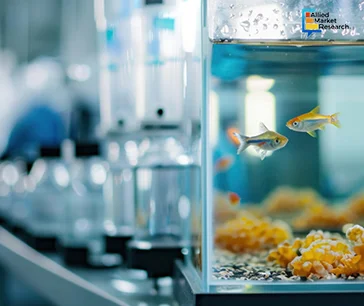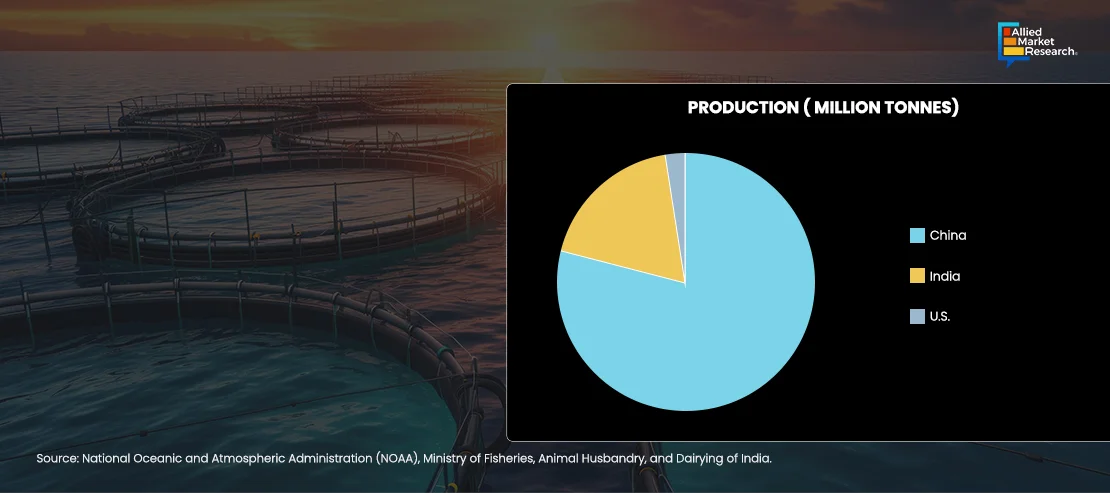Table Of Contents

Roshan Deshmukh

Koyel Ghosh
Blue Revolution: Exploring the Wave of Sustainable Aquaculture Growth

Sustainable practices are being prioritized to minimize environmental impact, with innovations such as Recirculating Aquaculture Systems (RAS) and automated feeding systems enhancing productivity. There's a notable expansion in the variety of species being farmed, including seaweed and new fish species resilient to climate change. The increasing consumer demand for high-quality, nutritious seafood is driving the industry to focus on producing fish rich in omega-3 fatty acids. The global trade of aquaculture products is also increasing, with countries like China, Norway, and Chile leading exports. According to the FAO, global aquaculture production reached 114.5 million Tonnes in 2020, valued at USD 263.6 billion. The industry significantly contributes to the economies of many countries, particularly in Asia, providing employment and income to millions. Governmental and private investments are also focused on sustainable practices to reduce the industry's environmental footprint. Key statistics from sources such as the FAO, NOAA, Eurostat, and China's Ministry of Agriculture and Rural Affairs highlight China as the leading producer, India’s growth in freshwater aquaculture, and Norway and Chile's prominence in salmon farming.
The rising consumer demand for seafood, technological advances, and strong government support, especially in the U.S., China, and India, are driving growth in the landscape. In the U.S., the growing preference for high-quality protein sources and health benefits of seafood, coupled with a focus on sustainability and the adoption of advanced technologies, has significantly boosted the industry. NOAA reported the U.S. aquaculture industry valued at approximately USD 1.5 billion in 2020, with production reaching about 608 million pounds in 2019. China, which produces over 60% of the world's aquaculture, benefits from high domestic demand, strong export markets, and significant government support. In 2019, its production exceeded 50 million Tonnes, according to the FAO. India’s aquaculture sector thrives on rising income levels, urbanization, and favorable climatic conditions, supported by initiatives like the Pradhan Mantri Matsya Sampada Yojana (PMMSY) aimed at enhancing fish production and sustainability. The Indian government reported the country’s aquaculture production at approximately 13.75 million Tonnes in 2020-21. These trends and statistics from NOAA, FAO, and respective national ministries highlight the significant role of aquaculture in meeting global food security needs and driving economic growth.
Aquatic Futures: The Rise of Smart Aquaculture
Smart aquaculture uses advanced technology to make fish farming more efficient and sustainable. These methods include IoT devices, automation, and data analytics, which enhance monitoring and management of aquatic environments. Fish farming, the base of aquaculture, involves the controlled cultivation of fish species for commercial purposes in freshwater or marine settings. Meanwhile, aquaponics merges aquaculture with hydroponics, fostering a symbiotic relationship where fish waste provides nutrients for plants, promoting resource efficiency and sustainable food production. These approaches are essential in terms of meeting global food security challenges while minimizing environmental impact and maximizing economic viability.

How to Tackle Sustainability, Disease, and Market Fluctuations
Aquaculture vendors happen to face significant challenges that impact their operations and sustainability, including environmental issues like water quality degradation, disease outbreaks causing up to 50% production losses, and market volatility with fluctuating seafood prices and consumer demand. They should also make the best use of strict regulatory compliance and deal with uneven access to and affordability of technological advancements. Addressing these hurdles requires a focus on sustainable practices, improved disease management, market resilience, and equitable technology access.

Adapting Aquaculture: AI Solutions for Climate Resilience
The aquaculture production varies significantly across different countries, with a few leading nations dominating the industry. According to Food and Agriculture Organization (FAO), China stands as the world's largest producer, contributing to 62 million Tonnes of aquaculture products annually. Following China, Indonesia produces 16 million Tonnes, and India accounts for 7.8 million Tonnes. Vietnam and Bangladesh produce 4.5 million Tonnes and 2.3 million Tonnes, respectively. Egypt and Norway each produce around 1.2 to 1.3 million Tonnes, with Chile also contributing 1.2 million Tonnes.
Climate change presents formidable challenges to aquaculture, affecting ecosystems important for fish health and disrupting production. The FAO warns that increasing temperatures and ocean acidification are changing water conditions, which are essential for achieving optimal aquaculture production. Additionally, NOAA notes increased storm frequency and droughts, causing infrastructure damage and economic losses in aquaculture operations. Amidst these challenges, artificial intelligence offers transformative solutions. AI-powered sensors provide real-time monitoring of water quality, optimizing environmental conditions to enhance fish growth efficiency while minimizing ecological impacts. Furthermore, AI algorithms predict disease outbreaks and optimize feeding schedules, reducing risks and improving overall production outcomes. The World Economic Forum emphasizes AI's potential in boosting aquaculture sustainability and profitability through advanced analytics and precision management. Government sources, such as the FAO, project a 3.2% annual reduction in global fishery production by 2050 due to climate change, highlighting the need for adaptive strategies within aquaculture. As the adoption of AI is increasing, it has become more important for fighting climate change and improving aquaculture.
Case Study
Sustainable Aquaculture in Rural America: The Success Story of Smith Family Aquafarms
Smith Family Aquafarms, nestled in a rural community in the Midwest, epitomizes the potential and challenges of small-scale aquaculture. Established by John and Sarah Smith in 2012, the farm spans across 10 acres and specializes in freshwater fish production, focusing primarily on tilapia and catfish. Operating with a commitment to sustainability, the aquafarm employs eco-friendly practices such as natural feed sources and environmentally conscious pond management techniques. This approach not only ensures high-quality, locally sourced fish but also minimizes ecological footprint.

The business strategy of Smith Family Aquafarms revolves around local market integration and community engagement. By supplying fresh fish to farmers' markets, restaurants, and community-supported agriculture (CSA) programs, the farm cultivates a loyal customer base appreciative of sustainable, traceable food sources. The Smiths focus on community engagement by hosting farm tours and outreach programs, which help locals understand and support aquaculture.
Smith Family Aquafarms deals with common small-scale challenges, such as limited funds for infrastructure and technology, difficulty reaching markets beyond the local area due to logistical issues, and the need to stay on top of regulatory requirements. Despite these hurdles, direct marketing has helped boost their local presence.
Despite challenges, Smith Family Aquafarms has succeeded by prioritizing quality, adaptability, and community support. Their reputation for sustainable practices and locally sourced products has solidified customer loyalty and community goodwill. Looking forward, the firm aims to enhance efficiency, explore value-added product opportunities, and expand market reach through strategic partnerships and online platforms. Smith Family Aquafarms exemplifies how small-scale rural aquaculture can thrive, contributing to food security, economic resilience, and environmental stewardship within its local community.
To Sum Up
In conclusion, the aquaculture market is evolving with technological advancements, sustainability efforts, and changing consumer preferences. The rising global seafood demand is evident that aquaculture is essential for sustainable protein production. Moreover, innovations in the aquaculture industry such as AI monitoring and precision farming have offered solutions to enhance efficiency and sustainability. Government support and international cooperation are indispensable for a favorable regulatory environment and promoting best practices. The diversification of market and eco-certification has strengthened consumer trust and has expanded opportunities for the aquaculture industry. The strategic R&D investments and collaboration on climate issues are also expected to shape a resilient landscape of aquaculture which is crucial for global food security and economic prosperity.
AMR analysis highlights that aquaculture businesses should prioritize sustainability to improve their business practices. Adopting eco-friendly practices, such as sustainable feed sourcing and efficient waste management, aligns with consumer demand for environmentally responsible products and boosts market demand. Investing in technologies like AI for predictive analytics and IoT for real-time monitoring would help optimize efficiency and reduce costs. Also, implementing strong traceability systems would ensure transparency, allowing consumers to track seafood origins and build trust. Strengthening market outreach through strategic partnerships, maintaining quality standards, educating consumers about sustainability, and adapting to regulatory changes are expected to enhance competitiveness and support sustainable growth. To get more insights into aquaculture trends, contact our specialists today!

